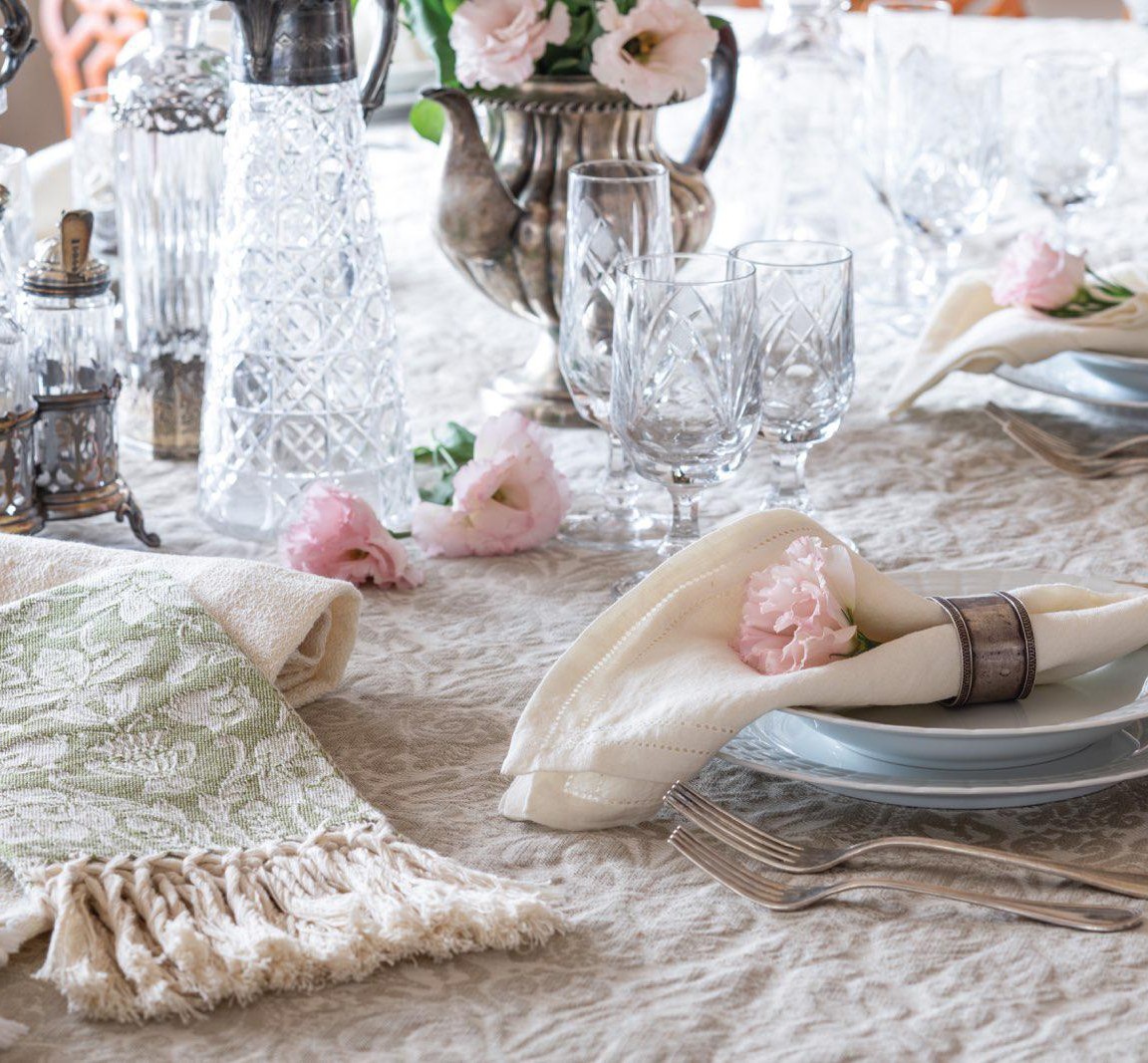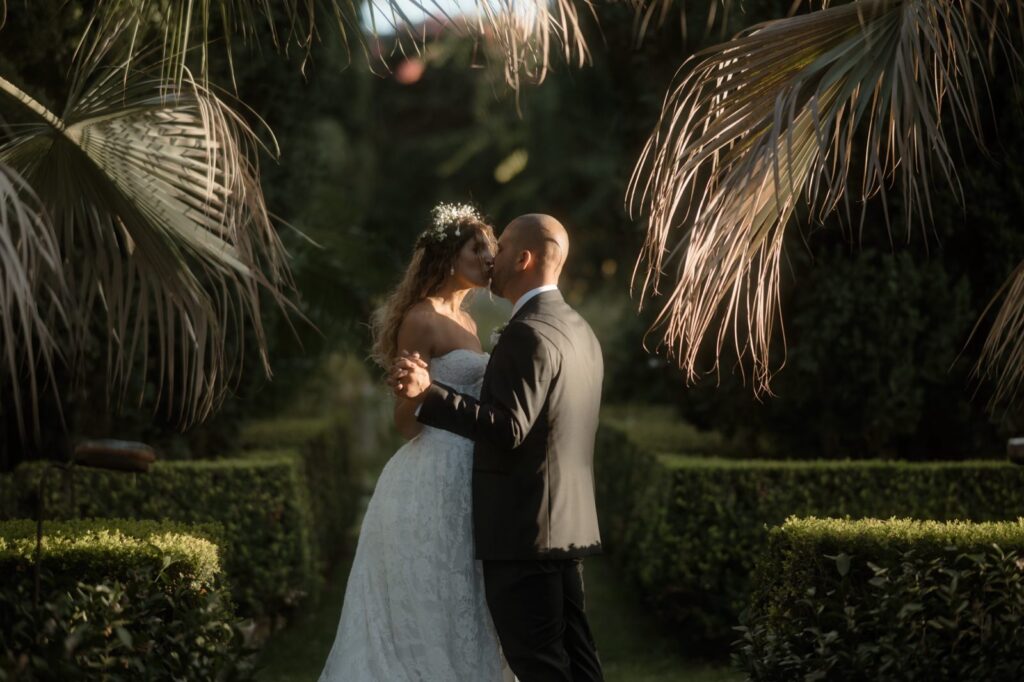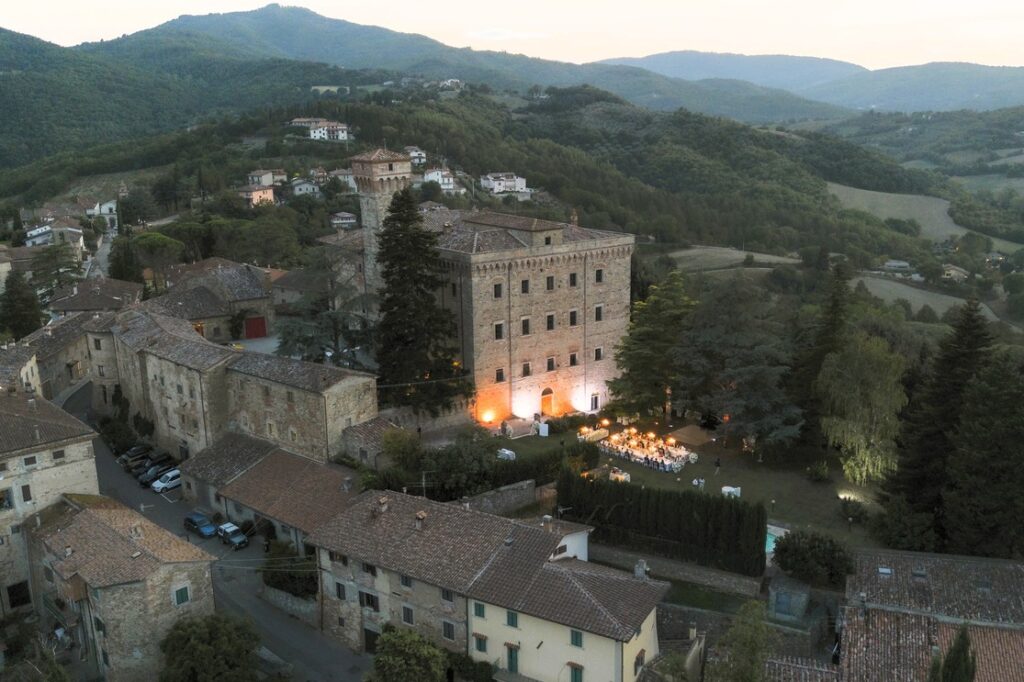Introduction: The Italian wedding table—Where beauty meets emotion
In an Italian wedding, the table is not merely a functional space—it is an emotional landscape, a celebration of togetherness, and a fundamental part of the reception experience, where style, warmth, and storytelling are woven into every detail. From the flicker of candles against hand-painted ceramics to the gentle rustle of linen napkins folded with care, every detail of the Italian wedding table setting is part of a deeper narrative: one that speaks of heritage, hospitality, and the art of living beautifully.
Get the Ultimate Guide to Italian wedding table
For international couples planning a destination wedding in Italy, designing the table becomes a bridge between cultures. It is where aesthetics meet emotion, and where personal style converges with centuries-old Italian traditions. The mise en place—literally “everything in its place”—is more than decoration; it is a visual and sensorial experience that welcomes each guest into your story.
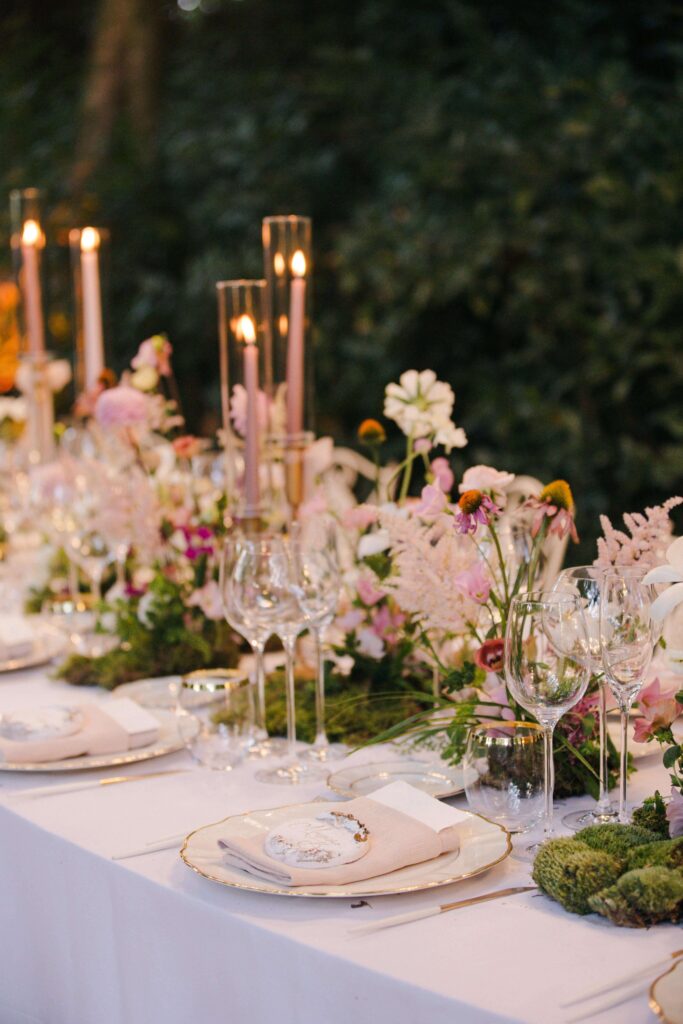
© Valentina Falleri Art Design
So what does a typical Italian wedding tablescape look like? The answer is as rich and diverse as the country itself. It could be a long wooden table under olive trees, adorned with ceramic vases filled with wildflowers and lit by hand-poured candles. Or it might take the form of an elegant villa dinner with linen napkins, gold-rimmed glassware, and softly draped floral garlands in blush and ivory. The beauty lies in the details—but more so, in the intention.In this article, we’ll explore how to craft an authentic Italian wedding tablescape that is both elegant and meaningful. We’ll look beyond trends to understand the timeless essence of Italian style, consider how to harmonize table design with your wedding’s overall aesthetic, and discover how local artisans and traditional materials can transform your mise en place into a work of art. Whether you’re dreaming of a romantic countryside dinner or a sophisticated villa banquet, you’ll find inspiration and practical guidance for creating a wedding table that tells your story—beautifully, authentically, and from the heart.
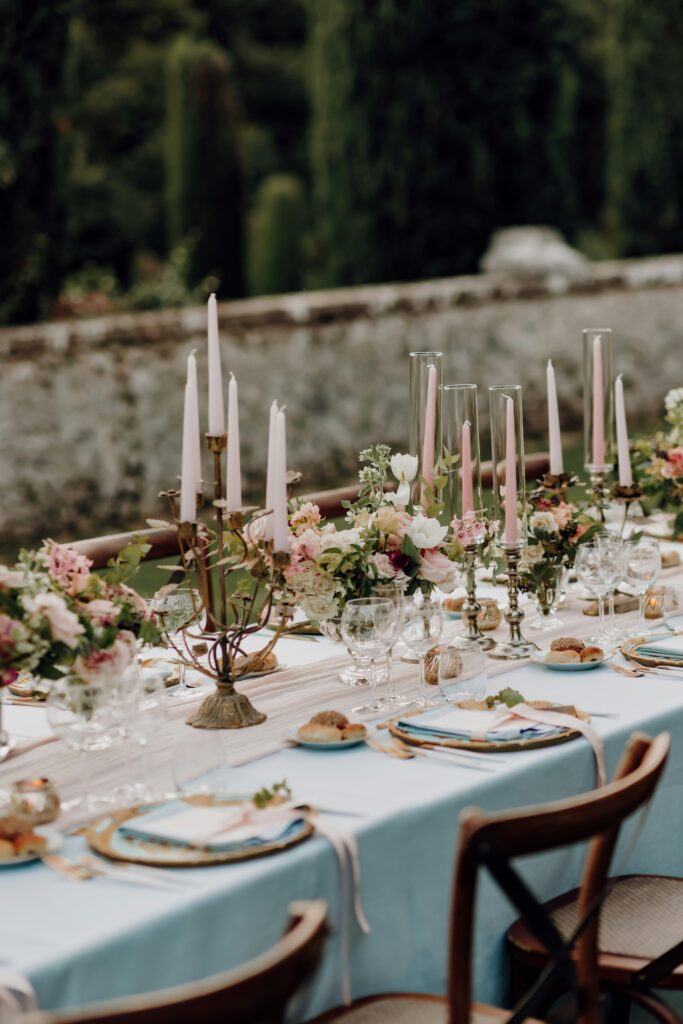
Chapter 1: Timeless Italian style vs. seasonal trends
In the world of weddings, trends come and go—but Italian style remains. It evolves slowly, gracefully, rooted in a deep cultural instinct for balance, elegance, and authenticity. When setting the table for a wedding in Italy, couples often face a familiar question: how do we make it feel personal and current, without sacrificing tradition?
There is, of course, inspiration to be found in the season. In 2025, trends like the Verona Sunset color palette—earthy terracottas, golden ambers, dusty pinks—offer warmth and romance. A return to “quiet luxury”, marked by understated refinement, layered textures, and thoughtful restraint, is also shaping wedding aesthetics. Mix-and-match tableware, imperfect hand-glazed ceramics, and softly draped fabrics reflect this desire for a tactile, curated feel.
But Italian wedding tables rarely follow trends for the sake of fashion. Instead, they interpret them through the lens of timelessness. A handmade Deruta charger plate doesn’t go out of style because its beauty lies in tradition. A fabric napkin, naturally dyed and gracefully wrinkled, feels relevant no matter the year. Even the use of florals—perhaps arranged with a looser, more organic composition—still echoes Italy’s long-standing relationship with nature and the land.
Choosing your Italian wedding tablescape is not about adhering to seasonal palettes or the latest buzzwords. It’s about asking what story you want your table to tell—and allowing that story to unfold with depth, soul, and enduring beauty. Trends can serve as gentle guides, but the heart of your mise en place should remain anchored in the timeless artistry of Italian hospitality.
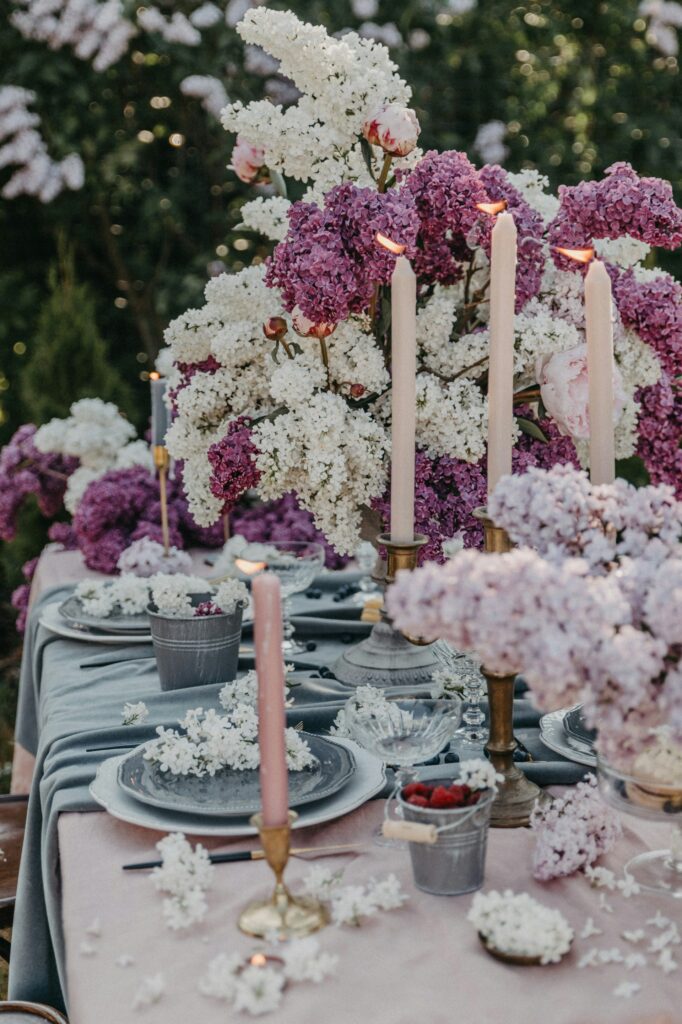
Chapter 2: The “Language of Style”—Aligning tablescapes with wedding aesthetics
A well-designed table is never random—it speaks the same language as the wedding itself. Whether your celebration is rustic-chic among the olive groves, minimalist in a modern villa, or elegant and classic in a Renaissance palazzo, the mise en place should echo and elevate the atmosphere you’ve envisioned.
In Italy, style is never rigid. It’s expressive, layered, and intuitive. A countryside wedding might call for natural wood tables, ceramic vases with spontaneous wildflowers, linen runners in neutral tones, and mismatched artisan plates. A classic and elegant celebration, on the other hand, may feature soft-hued tablecloths, crystal glassware, polished silver cutlery, and refined floral centerpieces in soft palette colors.
Minimalist weddings pair beautifully with pared-back styling: think white-on-white palettes, clean lines, and subtle textures. Mediterranean-inspired celebrations, so beloved in southern Italy, might incorporate vibrant blues, lemon yellow, or coral, with boldly patterned plates and colourful glassware, evoking a joyful, sunlit feast.
The table’s design should also reflect the shape and flow of the celebration. A long imperial table, perfect for villas and wine estates, invites a linear floral runner and candlelight that leads the eye along the table. Round tables, often used in more formal venues, benefit from balanced, radial compositions—central arrangements that create intimacy and symmetry.Ultimately, every detail on the table should harmonize with the tone, location, and emotional atmosphere of your wedding. When your mise en place feels connected to the broader vision—from the stationery to the setting—your guests will feel it too. The result is a harmonious experience, where beauty is not just seen but felt.
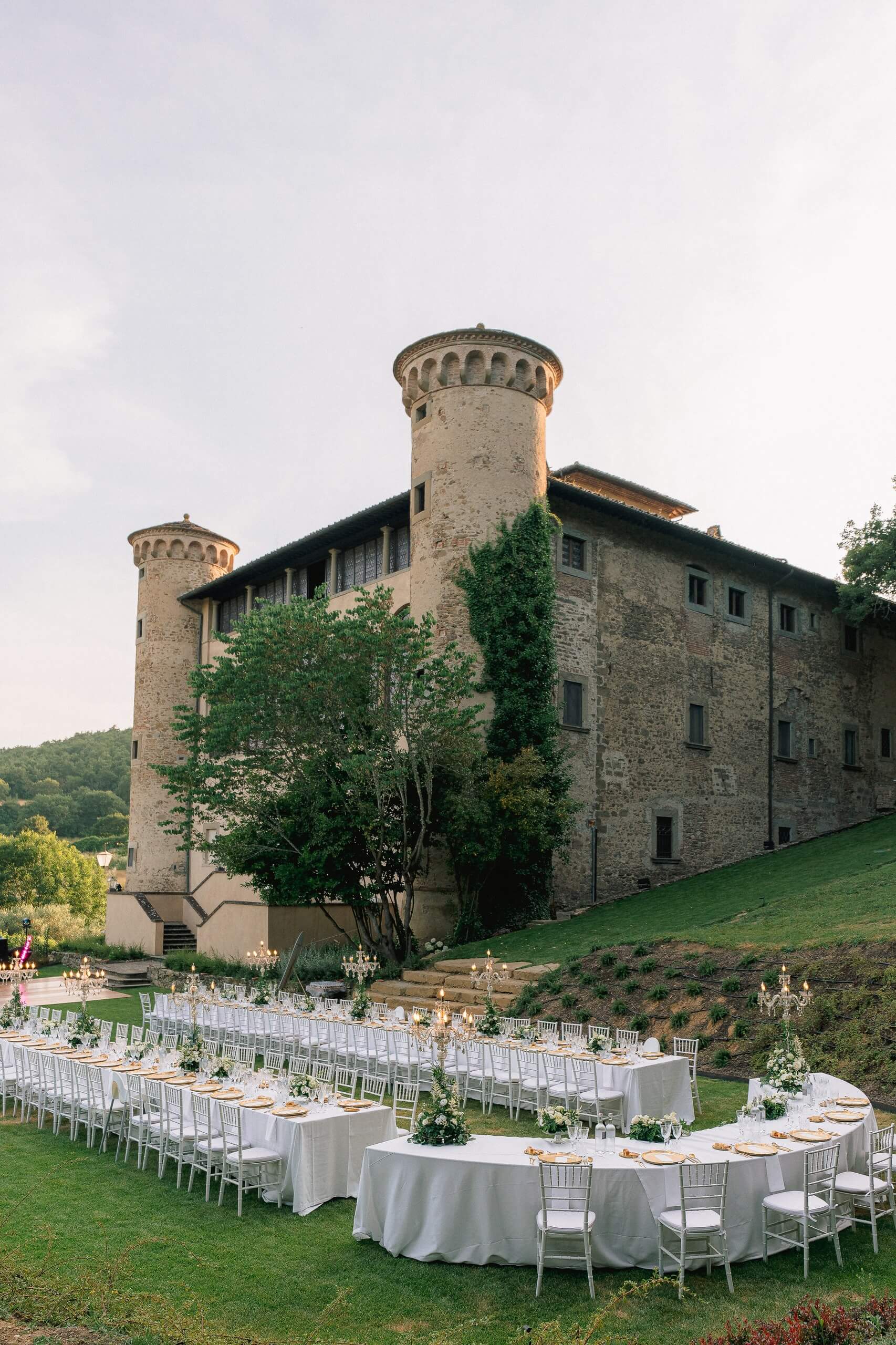
© Claudio Fasci
Chapter 3: The art of the table—Essential elements of an Italian wedding mise en place
When it comes to crafting an authentic Italian wedding tablescape, every object is chosen not just for function, but for feeling. Italians have a long-standing love affair with the art of the table—what is placed, how it is arranged, and above all, why it matters.
The foundation begins with the charger plate, or sottopiatto—a true statement of character. Whether in hand-painted Deruta ceramics or minimalist stoneware, this first layer sets the tone. In rustic settings, glazed terracotta or woven elements such as raffia placemats add earthiness and warmth. In more refined atmospheres, porcelain with delicate gold edges or silver charger plates lends understated elegance.
The textile elements complete the emotional and visual experience of the table. Depending on the style of the wedding, couples may choose to forgo a tablecloth entirely in favor of a linen runner placed over bare wood, evoking a warm, informal setting. In other cases, full-length tablecloths offer softness and elegance. For more relaxed or Mediterranean-inspired tables, placemats—from raffia to handwoven fabric—can add texture and intimacy while allowing the natural surface of the table to remain visible. Whatever the choice, textiles should always feel intentional, inviting, and connected to the overall palette and mood of the event.
Napkins in natural fibers, such as linen or cotton, bring tactile richness and are essential in anchoring the place setting. Whether left casually draped, softly crinkled, or neatly folded and tied with a ribbon or herb sprig, they should always be visually and texturally coordinated with the other fabrics on the table—tablecloths, runners, or placemats—to maintain a cohesive and refined look.
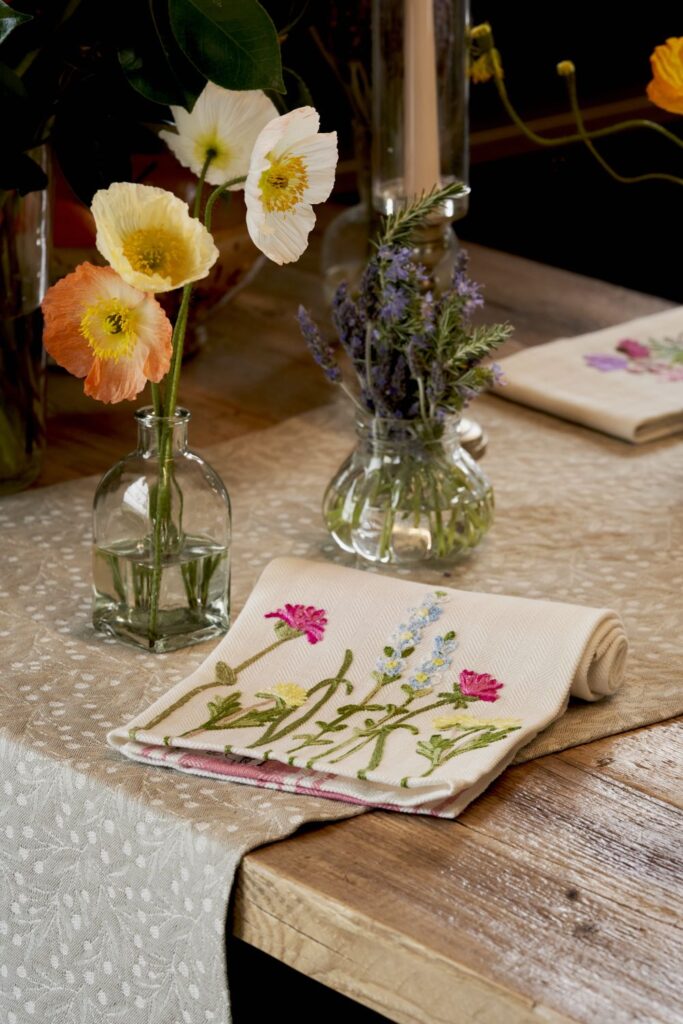
© Busatti
Glassware and cutlery are more than supporting elements—they’re essential accents. While clear crystal is often preferred for classic and formal settings, more relaxed or artistic tablescapes may feature colored or hand-blown glass goblets, adding vibrancy and artisanal charm—especially in countryside or coastal weddings where the atmosphere invites warmth and creativity. Gold or antique-silver cutlery, etched water tumblers, and refined finishes bring depth and personality to the setting. Layering different materials—ceramic, glass, linen, metal—creates a visual rhythm that feels collected, not forced.
Equally important is the wedding stationery that graces the table. Menu cards and place cards, when thoughtfully designed, do more than inform—they complete the mise en place. Their paper texture, typography, and layout should echo the tone of the event: elegant script for formal receptions, handmade paper for rustic-chic gatherings, or botanical illustrations for garden weddings. Whether resting atop the charger or tucked into the napkin fold, these details coherently tie together the visual story of the table, reinforcing the atmosphere and aesthetic with quiet sophistication.
Finally, think of the mise en place not as a checklist of items, but as a conversation between materials, context, and meaning. Let the venue, the meal, and your story guide the decisions. In Italy, beauty is rarely exaggerated—it’s simply allowed to emerge, one honest, intentional layer at a time.
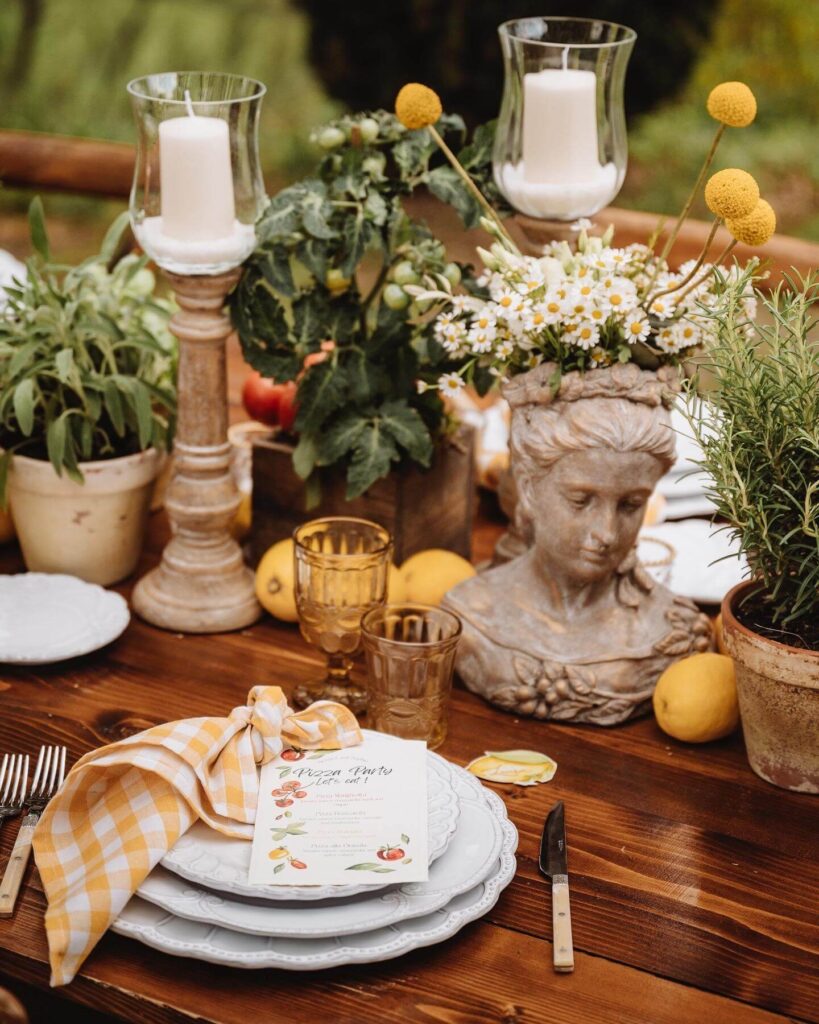
© Valentina Falleri Art Design
Chapter 4: Bringing in the craftsmanship at the wedding table
To create a table that feels truly Italian, there is no substitute for craftsmanship. In Italy, artistry lives not only in grand cathedrals or Renaissance frescoes—it lives in the woven threads of a napkin, the glaze of a ceramic plate, the texture of a hand-poured candle. A wedding table that incorporates artisan-made elements doesn’t just look beautiful—it carries the soul of the place.
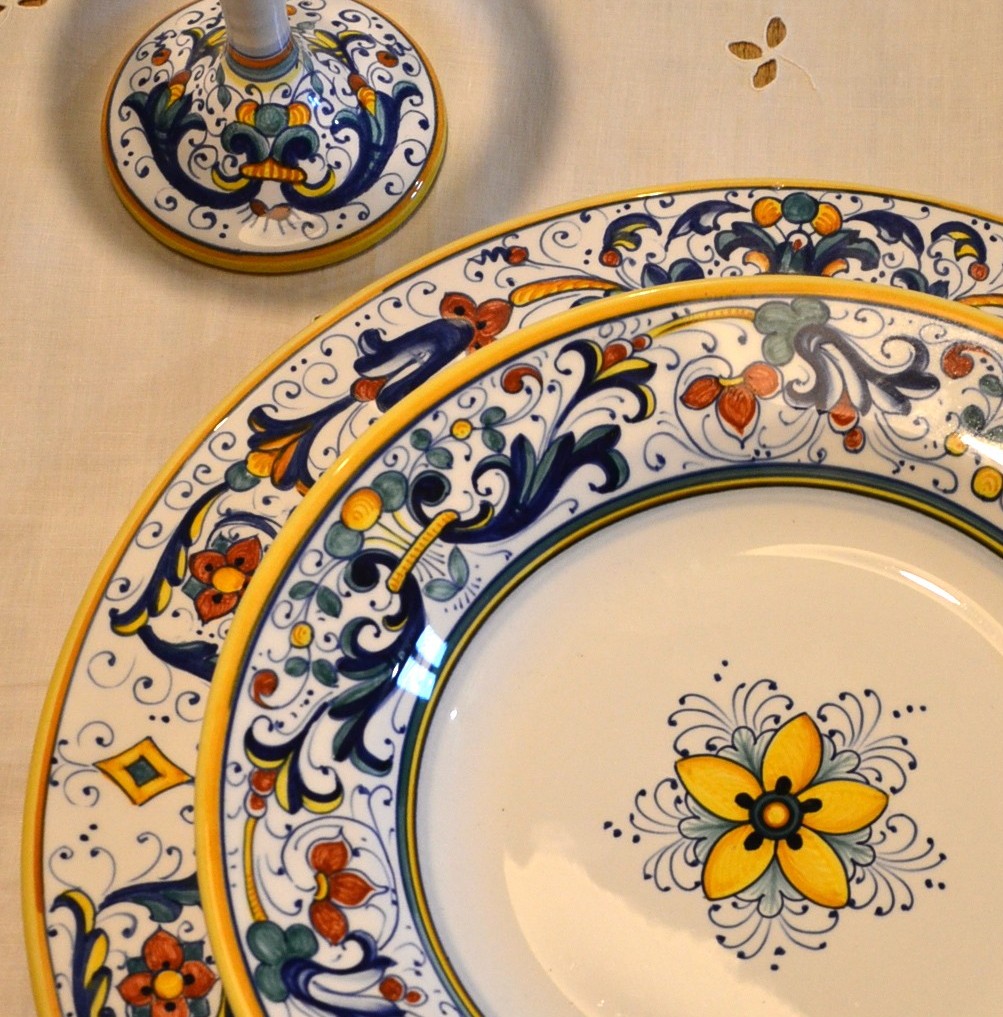
© Ceramiche Gialletti
One of the most expressive ways to add depth and authenticity to your mise en place is through handmade ceramics. In regions like Umbria, the town of Deruta has been producing painted majolica since the 16th century. Using a charger plate or small floral vase from Deruta instantly brings color, tradition, and artistic heritage to the table. No two pieces are ever identical—and that’s exactly the point. It’s the subtle irregularities that give them life. For couples wishing to include this tradition in their wedding table, workshops like Ceramiche Gialletti Giulio offer authentic, hand-decorated pieces that merge history and design with elegance and personality.
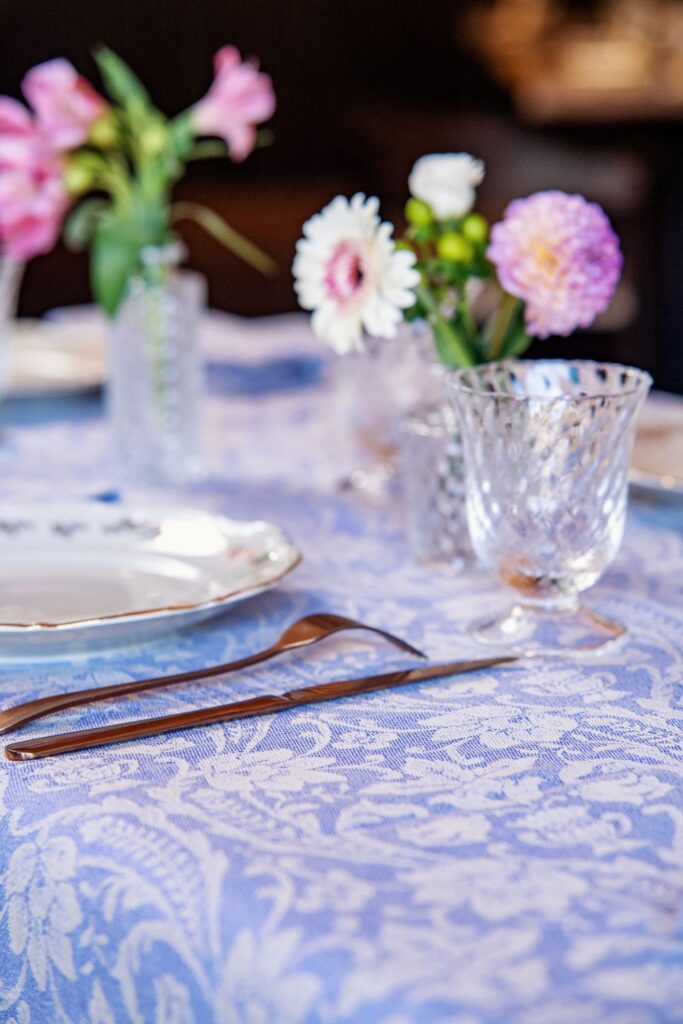
© Busatti
Another treasured detail lies in the textiles. In the medieval town of Anghiari, the Busatti family has been weaving fabrics since 1842, combining age-old techniques with a contemporary sense of style. Whether used for tablecloths, napkins, runners, or placemats, Busatti’s linens bring softness, texture, and quiet refinement to the table. Their natural hues—ecru, sage, dusty blue and pink—work in harmony with most palettes, and their weight and weave feel immediately luxurious to the touch. Many of their fabrics feature iconic woven patterns, ranging from elegant historical motifs to clean, modern designs—each one adding a subtle layer of identity and artistry to the mise en place. For couples seeking something truly personal, Busatti also offers made-to-order pieces, with the possibility to personalize each item with initials or custom details. Incorporating their textiles means adding not only beauty, but a piece of Tuscany’s living heritage.
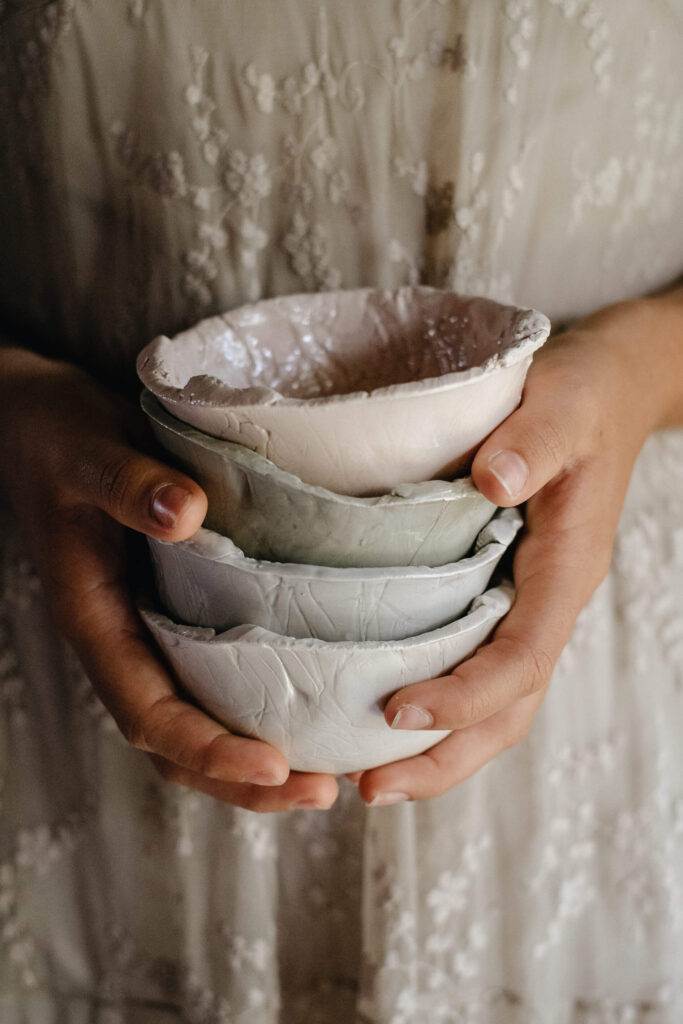
© Interra Ceramiche
Another beautiful interpretation of ceramic craft comes from Interra Wedding, a project rooted in the philosophy of imperfection and simplicity. Their hand-moulded pieces—such as underplates, small bowls, vases, or decorative tokens—have a raw, organic quality that brings soul and honesty to the table. Perfect for centerpieces, favors, or place settings, these ceramics add a tactile dimension that feels intimate, contemporary, and deeply human.
Then there are the small touches: tiny ceramic bud vases for scattered floral accents, handwoven baskets of local bread, or custom-cut wood elements that echo the landscape around you. These handcrafted pieces don’t need to be overused—they shine best when chosen with purpose and layered thoughtfully with other materials.
Incorporating artisan-made objects is not simply an aesthetic decision—it’s an act of cultural appreciation. It means honoring the land you’re marrying in, the people who shape it, and the traditions that continue to live through their work. The result is a wedding table that doesn’t just reflect good taste—it reflects meaning, presence, and a sense of place that no trend can replicate.
Get the Ultimate Guide to Italian wedding table
Chapter 5: Flowers as the heart of the tablescape
In an Italian wedding, flowers are never just a decoration—they are emotion made visible. Nowhere is this more true than on the wedding table, where florals breathe life into the mise en place and connect every guest to the mood, the atmosphere, and the couple’s unique story.
There is no single formula for floral design. Some couples envision abundant centerpieces, others prefer delicate arrangements that gently complement the place settings. What matters most is that the flowers feel meaningful and in harmony with the rest of the table: the linens, the ceramics, the candlelight, the rhythm of the shapes and colors.
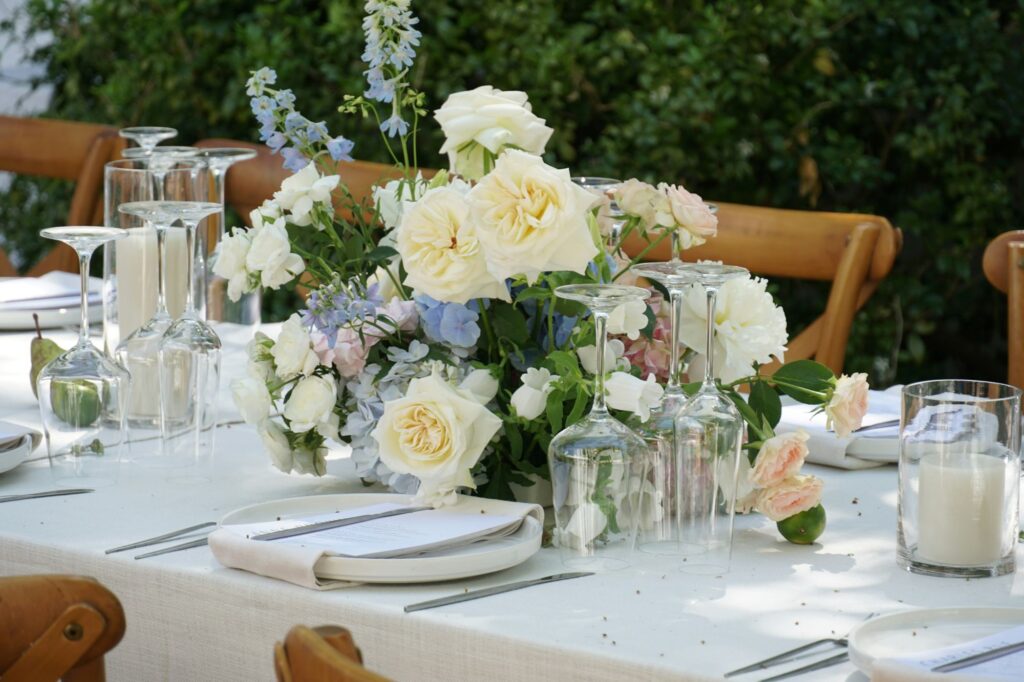
Often, the choice of floral styling reflects the wider aesthetic of the wedding. A minimalist celebration might call for restrained, tonal compositions; a more romantic setting might embrace layered textures and lush volumes. In every case, the flowers should elevate—not overpower—the mise en place, helping it feel intentional, elegant, and alive.
Working with local florists who embrace a seasonal and sustainable approach allows couples to create tablescapes that feel grounded in place and time. From the choice of vessels to the flow of the arrangements, every element can be curated to support a vision that is not only beautiful, but responsible and enduring.
For those who wish to dive deeper into floral design, you can explore our dedicated article: A Complete Guide to Floral Decorations for Weddings in Italy, where we share expert insights, inspiration, and practical advice on creating unforgettable floral atmospheres for your celebration.
Chapter 6: Nature on the table—Decorating with fruits and vegetables
In recent years, couples have begun embracing a timeless Mediterranean gesture: bringing seasonal fruits and vegetables to the wedding table—not only as part of the menu, but as part of the mise en place itself.
A bowl of figs, scattered pomegranates, branches of olive or citrus, even heirloom tomatoes nestled among florals—these elements introduce texture, depth, and a touch of the unexpected. They echo the surrounding landscape, reflect the rhythm of the season, and create a sense of abundance that feels generous and grounded.
This style of decoration is especially evocative in countryside or garden weddings, where nature is already part of the scene. But even in more elegant settings, a cluster of pears or grapes on a linen tablecloth can add a tactile, sensual richness to the composition—without compromising sophistication.
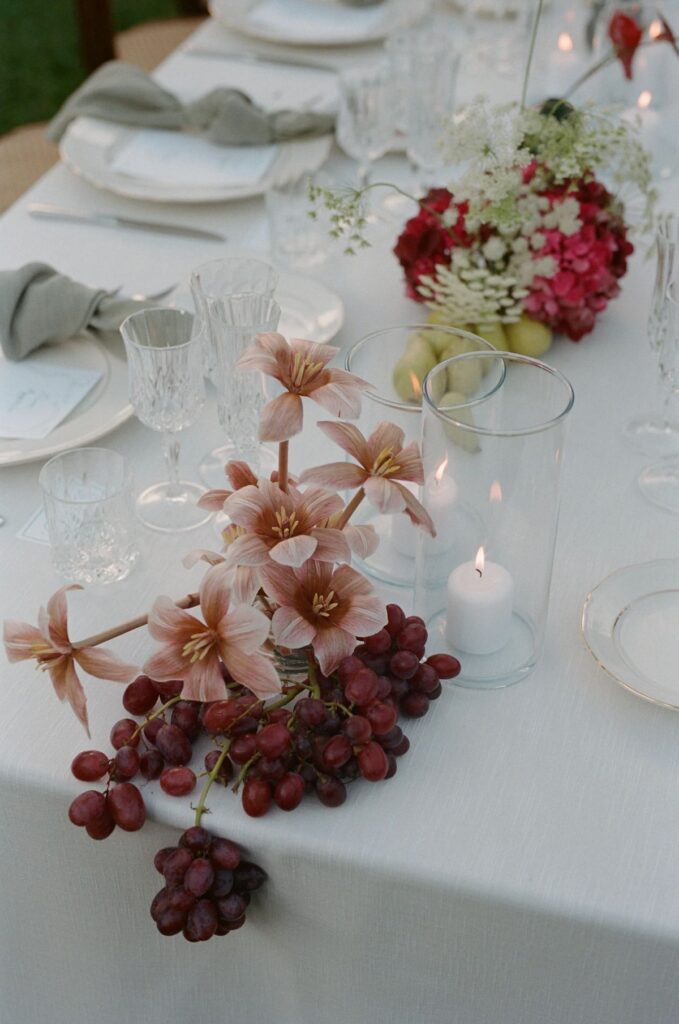
What makes this approach so appealing is its organic imperfection. Fruit and vegetables bring variation in shape, tone, and material. They complement candles, ceramics, and florals without overwhelming them, and they often carry symbolic meaning—fertility, joy, generosity.
Used thoughtfully, these elements become more than a visual detail. They become part of the table’s narrative—a celebration of nature, of place, and of simple, timeless beauty.
And when chosen wisely, they can be consumed after the celebration, turning beauty into nourishment and avoiding unnecessary waste.
Chapter 7: Plates, glassware, and cutlery—A mirror of the wedding’s soul
Every plate tells a story. Every glass reflects a moment. Every piece of cutlery marks a gesture. When thoughtfully selected, these everyday objects transcend their utility and become part of the mise en place’s emotional vocabulary—revealing the tone, personality, and elegance of the wedding itself.
The plate is often the anchor. Whether you choose hand-glazed ceramics, silver charger plates, or classic porcelain, its shape, texture, and finish will set the visual rhythm of the table. A soft matte plate might suggest simplicity and natural elegance; a glazed ceramic dish, artistic flair; a finely edged piece in bone white, timeless refinement.
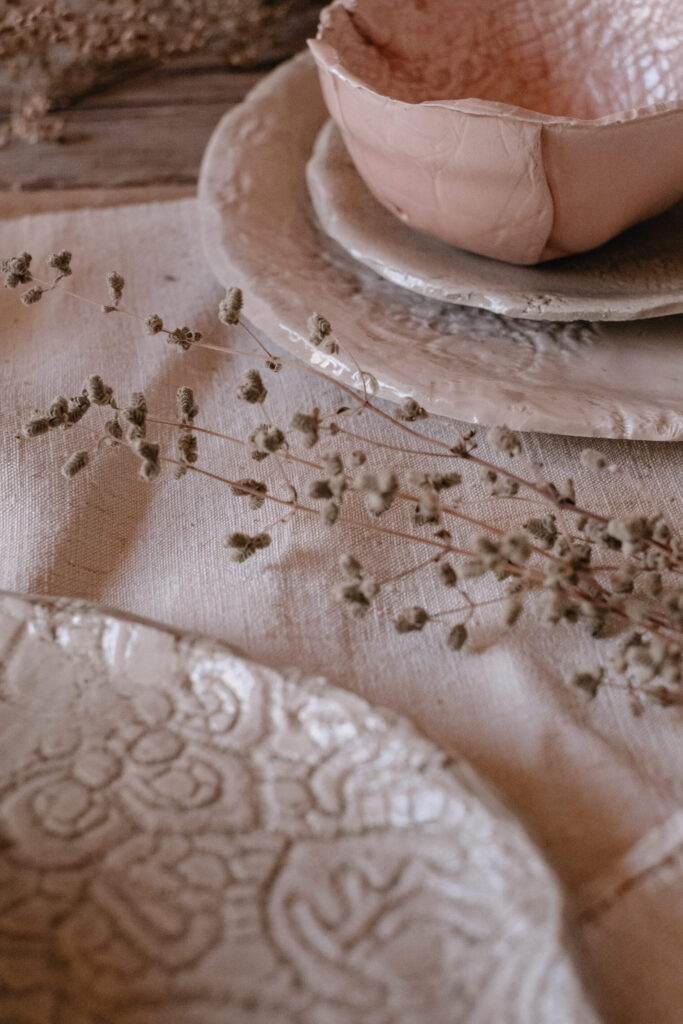
© Interra Ceramiche
Glassware, too, speaks its own language. Clear, crisp crystal is ideal for formal receptions, while tinted or hand-blown glasses can add character to more relaxed or expressive settings. Wine glasses, water tumblers, elegant champagne coupes—each contributes to the guest’s sensory experience, from the first toast to the final sip.
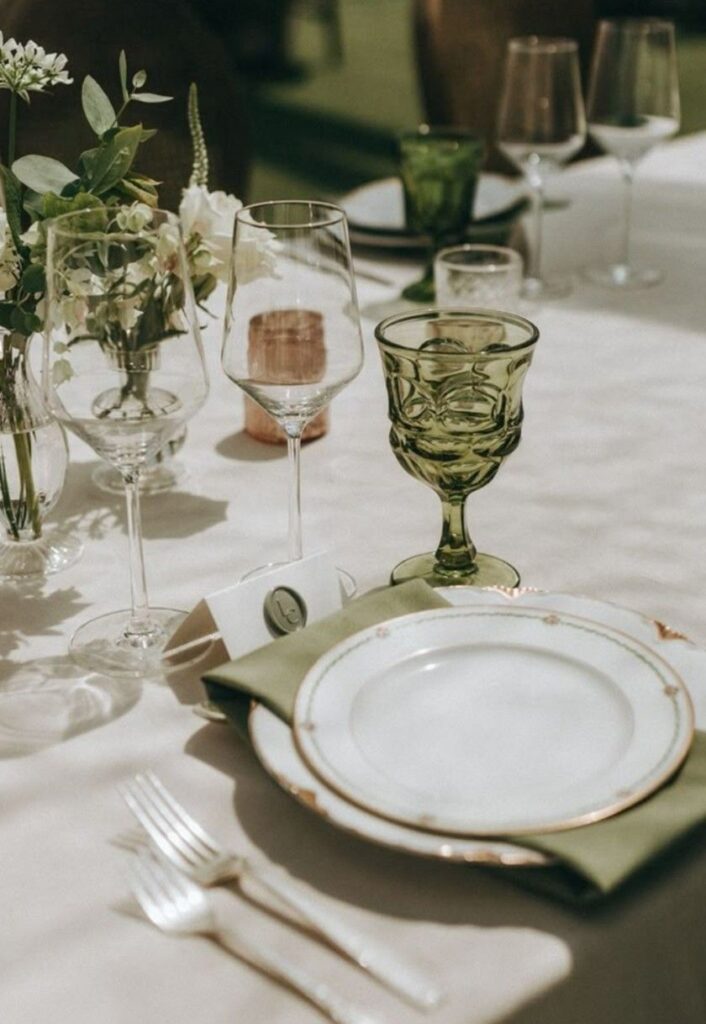
Then comes the cutlery, often underestimated but essential. A brushed gold set can warm a neutral palette; a vintage silver service can elevate a classic design. The weight, the finish, even the sound of cutlery resting on ceramic or linen adds to the overall perception of care and refinement.
What matters most is harmony. These elements should dialogue with the rest of the table—the linens, the florals, the candlelight—without shouting for attention. They should feel considered but effortless, curated yet natural. And above all, they should reflect the feeling the couple wants to share: simplicity, celebration, tradition, innovation, romance.
Because in Italy, even the smallest details are part of the experience. And the objects we touch—those that hold our food, our wine, our gestures—deserve to be chosen with the same emotion we bring to everything else.
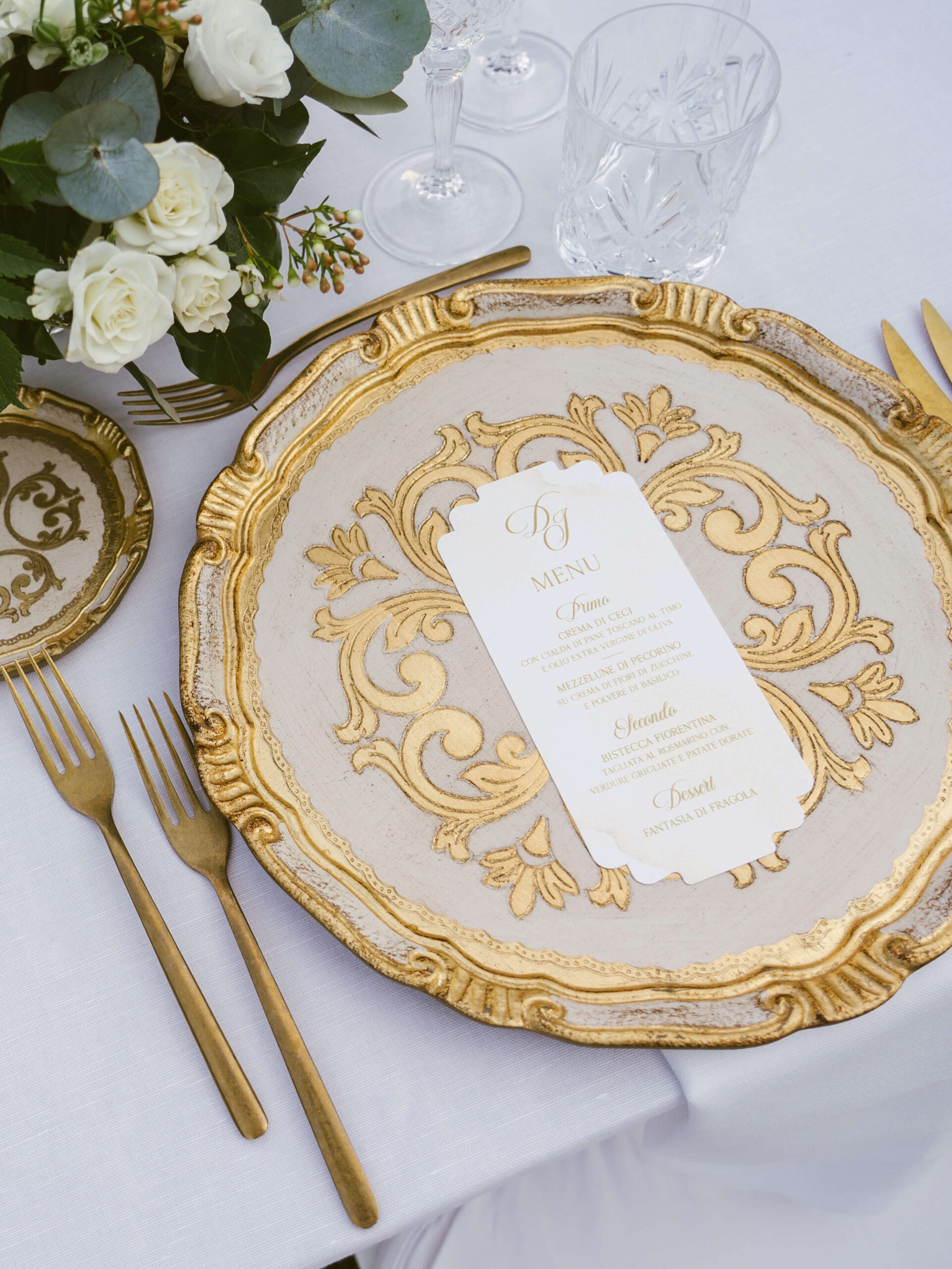
© Nicola Matteucci
Chapter 8: The planner’s insight—Logistics behind a destination tablescape
Designing a beautiful wedding table from afar is both a creative and logistical challenge. When planning a destination wedding in Italy, couples often imagine the soft linens, artisan ceramics, and candlelit ambiance—but few anticipate the behind-the-scenes coordination that makes it all happen.
The mise en place is not just about aesthetics—it’s about timing, quantities, sourcing, and consistency. A destination wedding planner ensures that the visual story you’ve envisioned is also logistically possible: that the right number of charger plates arrives on time, that glassware matches the style of the venue, and that delicate items like candles or custom vases are handled with care.
Rental timelines, for instance, vary across regions and suppliers. Some items—like artisan ceramics or embroidered linens—may need to be reserved well in advance or even custom ordered. Others, like floral vessels or candleholders, may require on-site testing to ensure they integrate harmoniously with the table layout and lighting.
Transport and access are also key considerations. A historic villa may have limited unloading space, or a countryside venue might require early setup due to distance. Each location has its own rhythm—and your planner orchestrates it so that everything arrives not only in place, but in perfect condition and ready to shine.
And then, there’s the visual flow. A skilled planner will balance beauty with functionality, ensuring that centerpieces don’t block conversation, menus are legible in the chosen font, and napkins are folded with intention—not just flair. Even the height of candles and placement of cutlery are chosen to support the overall harmony of the setting.A flawless mise en place requires more than taste—it requires expert coordination, local knowledge, and trusted relationships. That’s where the value of a destination planner truly reveals itself: behind every beautiful table is a team who thought of everything, so you don’t have to.
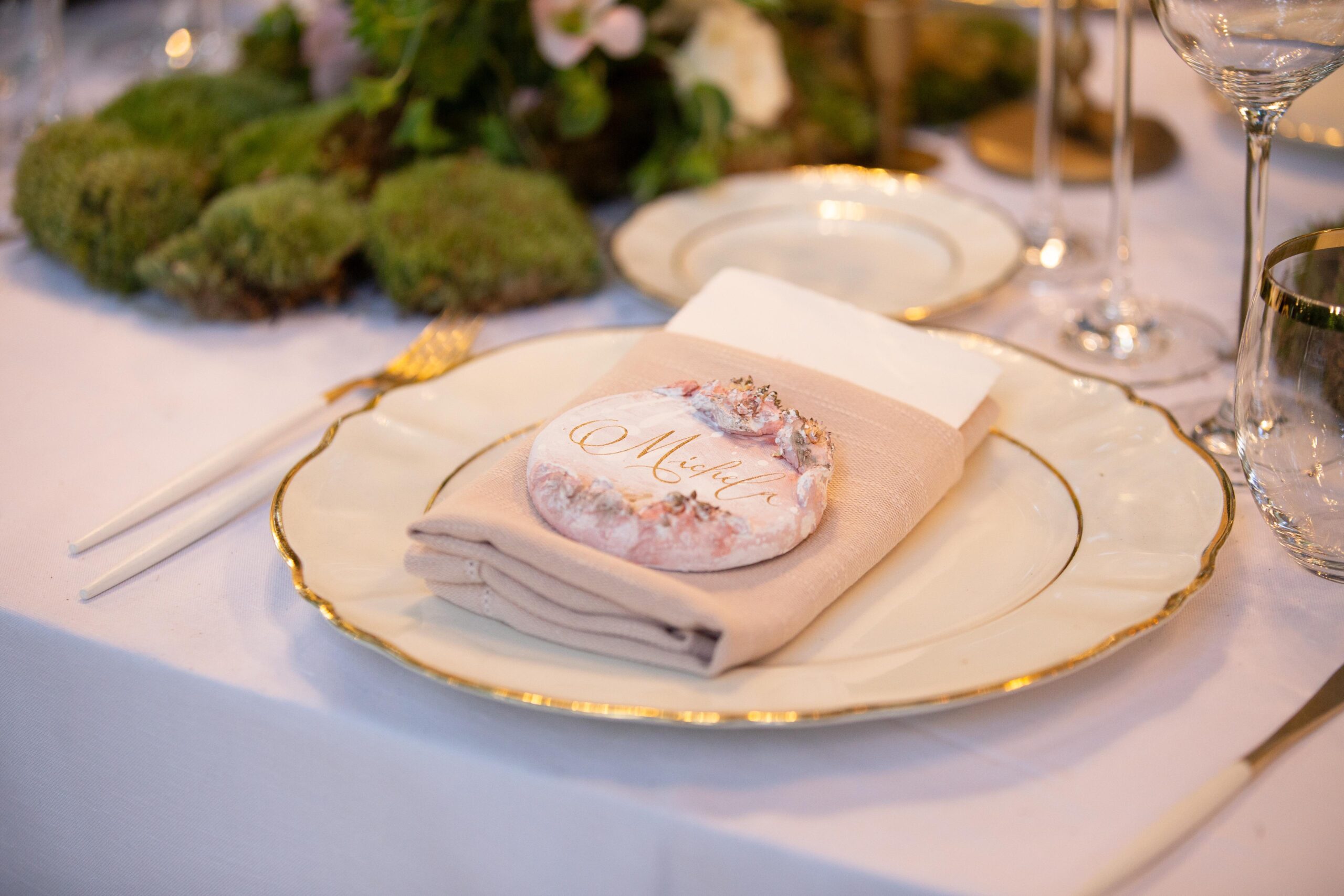
© Valentina Falleri Art Design
Conclusion: The table as storytelling
In Italy, a table is never just a table. It is the stage for connection, celebration, and memory. In the context of a wedding, it becomes something even more intimate—a reflection of the couple’s identity, their values, and the beauty they wish to share with those they love most.
Crafting an authentic Italian wedding tablescape is not necessarely only about following rules or reproducing trends. It can also be about composing a visual and emotional language made of objects, textures, and gestures; about choosing materials with meaning, honoring the land and artisans who shaped them, and allowing every element—from a linen napkin to a flickering candle—to speak with quiet elegance.
The mise en place is where style and soul meet. It is the first moment guests sit down and truly feel the atmosphere of your celebration. When thoughtfully curated, it doesn’t just set the scene—it tells a story that is both deeply personal and unmistakably Italian.
At Romantica Italia, we believe that beauty lies in these details—crafted with care, rooted in culture, and brought together with purpose. It’s our passion and privilege to guide couples through this process, helping them shape tablescapes that feel timeless, intentional, and entirely their own.
Get the Ultimate Guide to Italian wedding table
GET IN TOUCH

